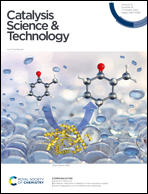Anti-symmetric exchange and hydrogen evolution in titanium halide monolayers
Abstract
In order to fulfil the energy requirement of mankind through a green and sustainable source of energy, monolayers (MLs) of titanium halides (TiX3) (X = F, Cl, Br) were studied using density functional theory, for their hydrogen evolution catalytic activity. With the R![[3 with combining macron]](https://www.rsc.org/images/entities/char_0033_0304.gif) space group, the optimized structures of TiX3 MLs attain the trigonal crystal symmetry. The computed lattice parameters for the optimized structures are a = b = 5.57 Å (TiF3 ML), 6.15 Å (TiCl3 ML) and 6.69 Å (TiBr3 ML). The structural stability has been determined from the cohesive energies of −5.74 eV per atom, −4.36 eV per atom and −3.98 eV per atom, for the TiF3 ML, TiCl3 ML and TiBr3 ML, respectively. The electronic properties of TiX3 MLs are spin dependent, i.e. for the up spin and down spin of electrons, the electronic properties are varied, which suggests the presence of magnetism. The computed magnetic moments per unit cell for TiF3, TiCl3 and TiBr3 MLs are 2.000 μB, 2.004 μB and 2.038 μB, respectively. TiF3 MLs and TiBr3 MLs exhibit semiconducting nature, with indirect electronic band gaps, whereas TiCl3 MLs possess half-metal characteristics. The variation in the structural parameters, under the influence of an electric field of 0.1 eV Å−1 to 1.0 eV Å−1, shows the presence of Dzyaloshinsky–Moriya interaction. The anti-symmetric exchange, in all three MLs, is evocative of good magnetoelectric effects. Further, the computed Gibbs free energies are 0.01 eV, 0.13 eV and 0.14 eV, for the TiF3 ML, TiCl3 ML and TiBr3 ML, respectively. From the calculated Gibbs free energy of TiF3 MLs for intermediate hydrogen adsorption, a remarkable catalytic activity for the hydrogen evolution reaction has been determined.
space group, the optimized structures of TiX3 MLs attain the trigonal crystal symmetry. The computed lattice parameters for the optimized structures are a = b = 5.57 Å (TiF3 ML), 6.15 Å (TiCl3 ML) and 6.69 Å (TiBr3 ML). The structural stability has been determined from the cohesive energies of −5.74 eV per atom, −4.36 eV per atom and −3.98 eV per atom, for the TiF3 ML, TiCl3 ML and TiBr3 ML, respectively. The electronic properties of TiX3 MLs are spin dependent, i.e. for the up spin and down spin of electrons, the electronic properties are varied, which suggests the presence of magnetism. The computed magnetic moments per unit cell for TiF3, TiCl3 and TiBr3 MLs are 2.000 μB, 2.004 μB and 2.038 μB, respectively. TiF3 MLs and TiBr3 MLs exhibit semiconducting nature, with indirect electronic band gaps, whereas TiCl3 MLs possess half-metal characteristics. The variation in the structural parameters, under the influence of an electric field of 0.1 eV Å−1 to 1.0 eV Å−1, shows the presence of Dzyaloshinsky–Moriya interaction. The anti-symmetric exchange, in all three MLs, is evocative of good magnetoelectric effects. Further, the computed Gibbs free energies are 0.01 eV, 0.13 eV and 0.14 eV, for the TiF3 ML, TiCl3 ML and TiBr3 ML, respectively. From the calculated Gibbs free energy of TiF3 MLs for intermediate hydrogen adsorption, a remarkable catalytic activity for the hydrogen evolution reaction has been determined.



 Please wait while we load your content...
Please wait while we load your content...